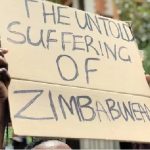 Zimbabwe is failing to keep prices of goods down because it is refusing to let its new currency, the Real Time Gross Settlement dollar, to trade freely on the market.
Zimbabwe is failing to keep prices of goods down because it is refusing to let its new currency, the Real Time Gross Settlement dollar, to trade freely on the market.
Economist Eddie Cross, who is also a member of President Emmerson Mnangagwa’s advisory council, argues that if the RTGS dollar was allowed to trade freely on the interbank market, the black market rate of the RTGS dollar against the United States dollar could actually decline from 5:1 to 3:1, the rate which the Reserve Bank of Zimbabwe seems to be comfortable with.
Writing in Newsday today, Cross argued those with foreign currency stood to make a profit of 50 percent by trading on the black market rather than on the interbank market.
“No exporter or beneficiary of diaspora remittance money can afford to ignore that sort of margin,” he said.
“So, when the Reserve Bank tries, in violation of the Monetary Policy Statement in February and, therefore, unlawfully, to hold the rate at a level below what is perceived as the real rate, then those holding foreign currency balances will shift their sales of such currency to the informal market. So, over the past month, I doubt if US$100 million has been traded on the formal interbank market.
“The effect of such activity is the opposite to what the Reserve Bank was trying to achieve. Price discovery is accepted as being the rate in informal markets and this then sets the rate at which local prices are determined. In many establishments, prices are listed in US dollars and the company then uses a rate — 4:1 to determine what we pay in ZWL$ or in bond notes. This has the effect of driving inflation rates even higher.
“One very unexpected development is that the much despised ‘bond notes’ issued as a surrogate local paper currency is actually trading at much stronger levels that the ZWL$. In fact, at 3.5 or 3.8 to 1.
“But the situation is actually worse than that because trade margins in the informal sector are much higher than those levied on any formal markets and between banks. Margins of 5% to 10% on individual transactions are reported. This means traders operating in the informal market are making huge profits and are reluctant to allow the trade to move into the formal market. In this, they are in fact supported by the banks themselves.
“My own view is that if the Reserve Bank had allowed full implementation of the monetary policy, this would have quickly resulted in the formal interbank market handling the bulk of the trades in foreign exchange in a transparent manner. Sales margins would decline to 1.5% or less and the commercial banks would be strengthened. Under such circumstances, I am also quite sure that market rates would strengthen to 3:1 or even less.
“This would reduce market prices as soon as this was recognised as the ‘real’ market rate. It would also allow everyone who needed foreign exchange to buy what they needed on the market through their banks. The conversion rates used by everyone for price discovery would decline to 3:1 or less; exactly where the RBZ wants rates to stabilise.
“My own view is that we need a weak currency to stimulate the productive sector and strengthen export activity. If we, under these circumstances, decided to hold the rate at, say, 3.5:1, we would have to buy US dollars rather than sell them to hold the rate at a lower rate. This would allow the RBZ to build up their foreign reserves, something we are going to have to do for debt clearance in the long-term.
“But what we are not facing up to is the need to mitigate the impact of these massive swings in policy on ordinary consumers. Since the programme was initiated, inflation has been at hyperinflation levels for months, and prices have doubled or trebled while incomes have stagnated.”
(761 VIEWS)


